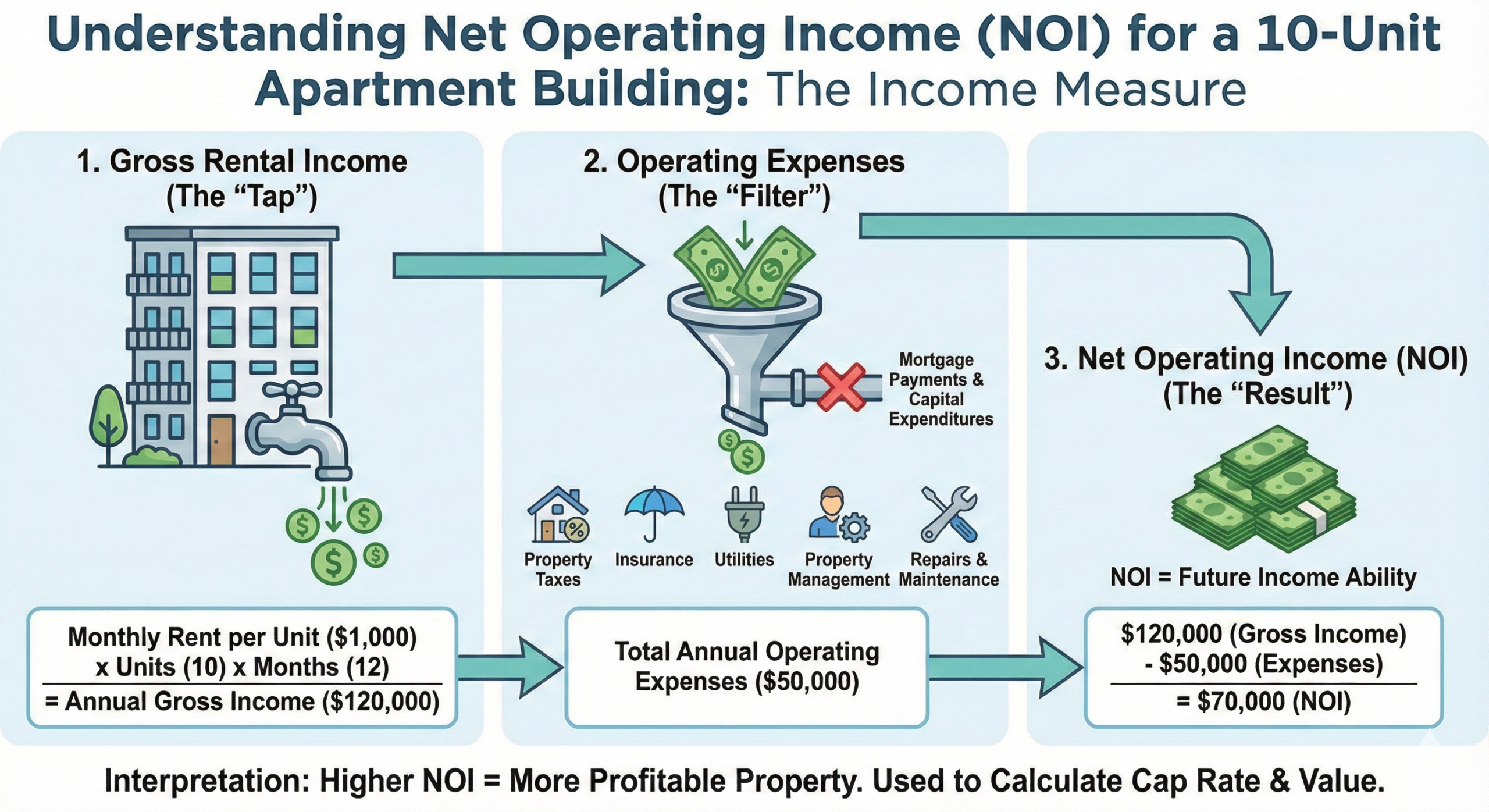Do you want to know how to value an apartment building? Getting a fair and accurate valuation is essential if you’re a property owner looking to learn how to value an apartment building. Many factors go into determining a property’s value, and it can be tricky to get it right. In this blog post, we will discuss three of the best ways to value an apartment building accurately.
Real estate valuation assists you in making better investing decisions. Learn what a capitalization rate is and how to value real estate.
Key Takeaways
- Get a professional appraisal if you have any doubts about the value of your property.
- Three of the methods – Income Valuation Method, Cost Approach Method, and comparative sales – can be effective ways to calculate the value of an apartment building.
- NOI is the sum of all revenue from the property minus all reasonably necessary running expenses.

3 Best Ways to Value an Apartment Building Accurately
Do you want to know how to value an apartment building?
Getting a fair and accurate valuation is essential if you’re a property owner looking to learn how to value an apartment building.
Many factors go into determining a property’s value, and it can be tricky to get it right. As a commercial real estate broker with over 18 years of experience, I’ve helped countless clients navigate this process. In this blog post, I’ll discuss three of the best ways to value an apartment building accurately.
Real estate valuation assists you in making better investing decisions. Learn what a capitalization rate is and how to value real estate.
Common Valuation Mistakes to Avoid
Many investors rely solely on historical income or comparable sales, overlooking future potential like renovations, neighborhood growth, or zoning changes. This can undervalue properties significantly. Understanding local market dynamics and hidden value opportunities helps achieve a more accurate valuation.
The Basics of How to Determine the Value of Your Apartment Building
Three of the methods – income valuation, sales comparison approach, and cost approach – can be effective ways to calculate the value of an apartment building. However, each method has its advantages and disadvantages. As a result, it’s important to understand all three methods before choosing which one to use.
| Valuation Method | Key Features | Advantages | Disadvantages |
|---|---|---|---|
| Income Valuation Method | – Based on potential income generation – Uses Net Operating Income (NOI) and capitalization rate | – Suitable for income-generating properties – Considers future cash flows | – Requires accurate expense and income projections |
| Sales Comparison Approach Method | – Compares property to similar recently sold properties – Considers factors like size, age, condition, and amenities | – Reflects current market conditions – Provides a tangible basis for valuation | – Requires sufficient comparable properties – Adjustments for property differences can be subjective |
| Cost Approach Method | – Calculates cost of constructing a new similar building – Subtracts depreciation based on age and condition | – Useful for new or unique properties – Considers replacement costs | – Less reliable for older properties – Does not account for market conditions or income potential |
Quick Valuation Checks
From my experience, I’ve found that potential buyers can perform some simple checks to quickly determine if an apartment building is priced fairly:
- Price per unit: For example, if a 4-unit building is listed at $1.2M, that’s $300K per unit. If similar nearby buildings sold for $250K per unit, this one may be overpriced.
- Price per square foot: If the property is 4,000 SF, that’s $300/SF. Compare this to the average for the neighborhood.
- Gross Rent Multiplier (GRM): If the building generates $96,000 in gross annual rent, the GRM is $1.2M ÷ $96,000 = 12.5. Compare this to typical GRMs in the area (e.g., 10–12) to assess fairness.
- Cap Rate: If the property’s net operating income (NOI) is $72,000, the cap rate would be calculated as $72,000 ÷ $1.2M = 6%. Compare this to typical cap rates in the market (e.g., 5–7%) to gauge if the investment aligns with your return expectations.
Option 1: Income Valuation Method
An income-based approach considers a business’s past, current, or forecasted future cash flows as well as the risk that the company may not meet its projected return. When determining what measure is used to determine a property’s ability to produce future income, investors typically look at the Net Operating Income (NOI), which provides the clearest picture of potential returns.
Multifamily Property Valuation Process Step-by-Step
Multifamily property valuation is a complex process that involves many factors. Here, I’ll walk you through the multifamily property valuation process step by step, so you can understand how it works.
First, we need to get a sense of the market and see what other similar properties are selling for in your area. We’ll look at several different metrics including price per square foot, occupancy rates and rents, and other indicators of value.
Next, we’ll consider how much it would cost to repair or renovate the property based on its current condition. (This is called an estimate of present value.) We’ll also consider how much income you’d be able to generate from renting out each unit (this is called an estimate of future value).
Finally, we’ll compare these estimates with what’s happening in other markets to determine whether this property is undervalued or overvalued relative to its competitors.
Multifamily Property Valuation Example Using the Income Approach
The revenue approach is a method of valuation that estimates the value of a property based on its potential for generating income. This approach is commonly used for properties that generate revenue, such as commercial buildings and rental properties. The value of the property is determined by discounting the future value of the expected rents by the capitalization rate.
The formula is: Value = NOI / CAP rate
A capitalization (cap) rate is the ratio of a property’s first-year Net Operating Income (NOI) divided by its purchase price. For example, an asset with an NOI of $80,000 and a cost of $1 million has an 8% cap rate ($80,000 divided by $1,000,000).
NOI = GOI – Operating Expenses
NOI is the sum of all revenue from the property minus all reasonably necessary running expenses. NOI is a pre-tax figure that appears on a homeowner’s income and cash flow statement and eliminates loan interest payments and principal payments, capital spending, depletion, and amortization.
For example, if a property has an NOI of $700k and is being appraised using an 8% cap rate method, it would be worth 8.75 million dollars.
Value-Added Improvements
The value of a property can be increased by making improvements that add to its overall cash flow. I’ve seen this first-hand in my work with clients.
One specific case involved a 6-unit apartment building in Echo Park, Los Angeles, CA that many buyers overlooked because the rents were already near the market. However, I identified hidden values others missed, all while ensuring full compliance with local rent control regulations:
- Garage-to-ADU Conversion: The detached garages offered an opportunity to legally add an Accessory Dwelling Unit (ADU) under current California or city zoning and ADU ordinances. Since it was a new, separately permitted unit, it could be rented at market rate without violating rent control rules.
- Laundry Income: The building had only one washer and dryer. We added additional machines and upgraded to a cashless system, increasing usage and monthly revenue—all without affecting tenant rents.
- Parking Charges: Several tenants had access to second parking spaces at no cost. After reviewing lease terms and rent control guidelines, we implemented a fair monthly charge for extra spaces where allowed, generating steady additional income.
- Community Amenities: For larger apartment buildings, we also converted an underutilized common area into a community office with high-speed Wi-Fi catering to tenant demand for work-from-home space or fitness facilities. This increased the appeal of the building and justified slightly higher rents for tenants who valued these added amenities.
These changes significantly improved the building’s income and overall value—without impacting existing tenants’ rent or violating rent control.
Option 2: Sales Comparison Approach Method
What is Sales Comparison and How it Works
The phrase “sales comparison approach” refers to a real estate appraisal technique that compares one property to comparable properties or those recently sold in the area.
This is one of the most commonly used appraisal methods, as it provides an accurate estimate of value by taking into account the prices of similar properties. The sales comparison approach is a method that real estate agents and appraisers may use to evaluate houses for sale.
It provides them with an excellent idea of what the market value for that type of property in that area is. To accurately compare properties, appraisers will consider factors such as size, age, condition, and amenities.
What are the sources of data for comparable properties?
To make informed decisions about real estate, it is essential to have access to accurate data. There are a variety of sources that can provide this data, including multiple listing services, deed records, tax records, and real estate agents.
In my practice, I use platforms like LoopNet Premium, CoStar, CREXi, AIR CRE Moody’s Analytics, Apartments.com, and Rent.com to gather comprehensive data on apartment comps (both active listings and recent sales).
Check The Local Market
The best way to find accurate data on comparable properties is to check the local market. This can be done by contacting a real estate agent or looking online. You can also look at public records to find out how much similar properties have sold for in the past.
Another way to find data on comparable properties is to appraise them yourself. This involves looking at the features of the property and comparing it to other similar properties in the area. You can also look at things like the location, size, and condition of the property. This information can help you come up with a fair value for your property.
Make Use of Commercial Real Estate Platforms
When looking for data on comparable properties, there are a few different sources you can use. One option is to look up information on commercial real estate platforms like CoStar and LoopNet. These websites usually have a database of properties that you can search through, which can help find similar properties in your area. You can also often find detailed information on these platforms, such as photos, square footage, and rental rates.
Option 3: Cost Approach Method
Calculating the cost of new construction
As anyone who has ever built a house will tell you, the cost of construction is always more than the initial estimate. There is a multitude of factors that can drive up the price of building a home, from the cost of materials to the fees for permits and inspections.
As a result, it is important to have a clear understanding of your construction costs before you begin the building process. One way to do this is to calculate your cost per square foot.
This will give you a good idea of how much it will cost to build your new home, and it will help you budget accordingly. To calculate your cost per square foot, simply divide your total construction costs by the total square footage of your home.
For example, if your new home is 2,000 square feet and your builder estimated that it would cost $350,000 to build, then your cost per square foot is $175. By understanding your costs in advance, you can avoid any unpleasant surprises down the road.
Calculating depreciation
Depreciation is defined as the gradual reduction in the value of an asset due to normal wear and tear. The formula used to calculate depreciation is the number of years after construction divided by the total useful age of the structure.
For example, if a building was constructed 10 years ago and has a useful lifespan of 50 years, the depreciation would be 10/50, or 20%. This means that the current selling price of the building would be 80% of the original selling price.
However, it’s important to note that this is only a general guideline, as many factors can affect the rate of depreciation for a particular property. For example, well-maintained buildings will typically experience slower depreciation than those that are not well-cared for.
The Impact of Local Market Factors
As a commercial broker, I’ve found that standard formulas like price per unit, GRM, and cap rates often overlook the local market dynamics that can significantly influence real value. These formulas typically don’t capture factors such as:
- Rising rents in emerging neighborhoods
- Apartment shortages in growing areas
- Local job growth trends
- Changes in zoning or redevelopment standards
- Rent control ordinances and their impact
- Development of new amenities like parks, restaurants, and retail spaces
Additionally, local demographic shifts, such as an influx of younger professionals or changing household sizes, can create increased demand for specific types of units. While these trends can influence long-term appreciation and rental income, they are often absent from traditional valuation methods.
For example, a neighborhood experiencing gentrification may see rising rental demand long before cap rates reflect that change. New developments, such as parks, restaurants, transit stations, or retail corridors, can make an area more desirable, driving future rent growth. Zoning changes that allow for higher density or mixed-use development can also enhance a property’s potential significantly over time.
Rent control is another important local factor, particularly in cities like Los Angeles. Each jurisdiction has its own regulations regarding rent increases, pass-throughs, and tenant protections. A property that seems limited under current rules may still offer hidden opportunities through legal rent adjustments or capital improvement programs.
Common Valuation Mistakes
One of the most common mistakes I see is investors relying too heavily on historical income without fully accounting for the property’s future potential.
Many buyers base their valuation strictly on the current rent roll and expense statements, which can cause them to overlook untapped opportunities like renovations, underused spaces, or upcoming neighborhood improvements that could significantly increase long-term returns.
For instance, some properties have the potential to convert unused garages or storage areas into rentable ADUs (Accessory Dwelling Units), or they may benefit from infrastructure upgrades, new transit developments, or rezoning efforts already in motion. These improvements often fly under the radar but can dramatically increase property value and cash flow.
Another factor investors frequently miss is the impact of local stakeholder groups, like neighborhood councils. These organizations often push for improvements or zoning changes that can spark revitalization—and appreciation—in specific pockets of the city. Failing to consider this kind of local advocacy can lead to underestimating a property’s upside.
In rent-controlled areas like Los Angeles, landlords also forget that there are limited paths to increase income—but they do exist. Under the Los Angeles Rent Stabilization Ordinance (RSO), property owners may apply for a “Just and Reasonable Rent Increase” through the Los Angeles Housing Department (LAHD). This option is available when a landlord’s operating expenses exceed rental income and the standard annual rent increase (capped and tied to CPI) doesn’t allow for a fair return.
To qualify, landlords must demonstrate:
- A drop in Net Operating Income (NOI) below a reasonable return level (usually benchmarked to a base year).
- A significant rise in operating costs, such as property taxes, maintenance, or utilities.
- Completion of capital improvements not already covered under other rent pass-through provisions.
While the application process is detailed and not guaranteed, it’s an important tool for owners who are operating at a loss and may justify a higher-than-usual rent increase under RSO guidelines.
The bottom line: Savvy investors look beyond the spreadsheet. They evaluate the property’s income potential, market trajectory, and the influence of local governance to truly assess value—not just what’s on paper today, but what’s possible tomorrow.
My Approach to Different Apartment Building Classes
As a commercial broker, I adapt my valuation strategy based on the building’s size, class, and market segment. I typically start with the income approach—emphasizing actual and projected net operating income—and cross-reference that with the sales comparison approach, adjusted for local comps and property-specific upgrades.
I take a close look at physical factors like recent capital improvements (new roofing, plumbing, HVAC), unit renovations, and deferred maintenance, alongside external drivers such as neighborhood amenities, household income growth, proximity to job corridors, and announced infrastructure or zoning changes.
From there, I run investment metrics including cap rate trends, gross rent multipliers, debt coverage ratios, and local rent comps to ensure the valuation is grounded in both current and forward-looking conditions. My aim is to deliver a price that reflects not just performance today, but the building’s positioning for long-term upside.
How To Value an Apartment Building in 30 Minutes
When you find an interesting apartment building for sale, you’ll want to quickly determine if the price is fair before investing time in property visits and negotiations. Here’s how I help my clients estimate an apartment building’s value in just 30 minutes using four simple methods.
Step 1: Gather Your Data (10 minutes)
First, find three similar properties (called “comparables” or “comps”) that:
- Are within 10 miles of your target property
- Have similar ages and condition
- Are currently for sale or sold in the last year
- Have a similar number of units
You can find this information through:
- Real estate websites like LoopNet or Zillow
- A local commercial real estate broker
- Property listing services
For each property (including your target), collect:
- Purchase price
- Number of units
- Annual gross rent (assuming 100% occupancy)
- Net Operating Income (NOI)
Step 2: Calculate Values (20 minutes)
Method 1: Price per Unit
This method compares the cost per apartment unit across properties.
| Property | Price | Units | Price per Unit |
|---|---|---|---|
| Target | $2,310,000 | 16 | $144,375 |
| Comp 1 | $2,295,000 | 16 | $143,438 |
| Comp 2 | $2,780,000 | 18 | $154,444 |
| Comp 3 | $2,450,000 | 17 | $144,118 |
Average price per unit: $146,594 Estimated value: $146,594 × 16 units = $2,345,504
Method 2: Gross Rent Multiplier (GRM)
GRM shows how many years of rent it would take to pay for the property.
| Property | Price | Annual Rent | GRM |
|---|---|---|---|
| Target | $2,310,000 | $258,800 | 8.9 |
| Comp 1 | $2,295,000 | $250,600 | 9.2 |
| Comp 2 | $2,780,000 | $306,500 | 9.1 |
| Comp 3 | $2,450,000 | $296,750 | 8.3 |
Average GRM: 8.9 Estimated value: $258,800 × 8.9 = $2,303,320
Method 3: Capitalization Rate
Cap rate shows the return on investment based on the property’s income.
| Property | NOI | Price | Cap Rate |
|---|---|---|---|
| Target | $150,950 | $2,310,000 | 6.5% |
| Comp 1 | $142,290 | $2,295,000 | 6.2% |
| Comp 2 | $186,260 | $2,780,000 | 6.7% |
| Comp 3 | $147,000 | $2,450,000 | 6.0% |
Average cap rate: 6.35% Estimated value: $150,950 ÷ 0.0635 = $2,376,535
Method 4: Average of All Methods
For the most balanced estimate, average the results from all three methods:
| Method | Estimated Value |
|---|---|
| Price per Unit | $2,345,504 |
| GRM | $2,303,320 |
| Cap Rate | $2,376,535 |
| Final Average | $2,341,786 |
What Measure Is Used To Determine A 10-Unit Apartment Building’s Ability To Produce Future Income?
To determine a 10-unit apartment building’s ability to produce future income, the measure commonly used is the Net Operating Income (NOI). NOI is calculated by subtracting the property’s operating expenses from its gross rental income.

Here’s how to calculate NOI:
Gross Rental Income: This is the total income generated by the property, assuming all units are rented out at market rates. It is calculated by multiplying the monthly rent per unit by the number of units (10 in this case) and then multiplying the result by 12 to get the annual gross rental income.
Operating Expenses: These are the costs associated with running and maintaining the property, such as property taxes, insurance, utilities, property management fees, repairs, and maintenance. It is important to note that operating expenses do not include mortgage payments or capital expenditures.
Net Operating Income (NOI): NOI is calculated by subtracting the annual operating expenses from the annual gross rental income.
NOI = Annual Gross Rental Income – Annual Operating Expenses
For example, if the monthly rent per unit is $1,000 and the annual operating expenses are $50,000, the NOI would be:
Annual Gross Rental Income = $1,000 × 10 units × 12 months = $120,000 NOI = $120,000 – $50,000 = $70,000
The NOI provides investors with a clear picture of the property’s ability to generate income after accounting for necessary expenses. A higher NOI generally indicates a more profitable investment property. Investors can use the NOI to calculate other important metrics, such as the Capitalization Rate (Cap Rate), which helps determine the property’s value and potential return on investment.
Where Can I Find Apartment Units For Sale?
If you’re looking for apartment units for sale, there are several avenues you can explore. Start by searching online real estate listings on platforms like Zillow, Redfin, or Realtor.com.
These websites often feature a wide range of apartment units available for purchase. You can also engage the services of a real estate agent who specializes in multi-family properties. They can provide you with listings that match your criteria and guide you through the buying process.
Another option is to attend real estate auctions or explore off-market opportunities through networking with other investors or property owners. Additionally, consider connecting with me, Mike Tolj.
With over 18 years of experience in the industry, I have a proven track record of helping clients find the perfect apartment units for their needs. My extensive knowledge of the market and dedication to client satisfaction make me a valuable resource in your search for the ideal investment property.
How to Quickly Estimate Apartment Building Value
Investors often need fast valuation estimates before deeper analysis or inspections. Simple checks like price per unit, gross rent multiplier (GRM), and capitalization rate (cap rate) comparisons against local comps help gauge fairness and investment potential quickly.
FAQs
What determines the market value of an apartment?
Are apartment buildings a good investment?
What is the 2% rule in real estate?
How much value do a washer and dryer add to an apartment?
How to calculate the price of an apartment?
-Calculate land value share
– Add depreciated building value (including amenities)
– Include overhead costs and expenses
This sum gives you a rough estimate of the apartment’s market value. Factors like location and market trends also influence the final price.
Conclusion
The best way to get an accurate apartment estimation of your apartment building’s value is to have it professionally appraised. However, if you’re looking for a ballpark figure or want to know what factors influence the value, there are other methods available. By understanding the different apartment valuation methods and how they work, you’ll be in a much better position to make an informed decision about the sale or purchase of apartment buildings for sale.
Have questions? Give me a call or schedule a free consultation– I’d be happy to help!




